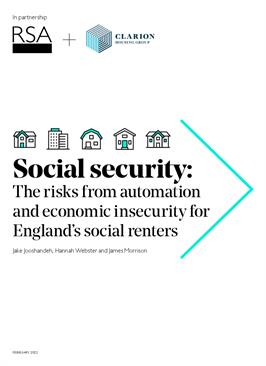This research, carried out in partnership with Clarion Housing Group, seeks to understand how social renters experience economic security, their access to good work and how technological changes to workplaces might impact their futures.
We bring together quantitative data, qualitative insights and macro trend analysis to identify current barriers to economic security.
We test the hypothesis that, by virtue of the allocations system and limited market, those living in social housing experience higher levels of economic insecurity, before exploring a shift in our social housing provision towards the needs of the individuals. Such a shift, in the context of wider systemic change, will enable our model of housing to actively support a move toward economic security for its residents.
We find:
- Social renters have the lowest overall levels of subjective financial security: 41 percent of social renters experience low subjective financial security.
- Social renters are more likely to have ‘affordable’ rents (less than 30 percent of income): 88 percent of social renters have affordable rents, compared to 79 percent of private renters.
- The social renters we spoke to indicated that their home had given them the security and stability they needed often in times of critical personal need.
- When employed, people in social housing are less likely to benefit from good work practices that support their economic and personal security: only 38 percent of social renters are in work which offers them an annual incremental pay increase, and three quarters (74 percent) never worked from home, even in the height of the pandemic.
- Social renters are at greatest risk of trends in automation: 61 percent of working social renters are in high automation risk jobs, compared to a population average of 39 percent. Just 13 percent are in low-risk jobs, compared to an average of 34 percent.
- Three quarters (74 percent) of social renters have a level 2 qualification or below.
- Social renters in retail occupations are at the highest immediate risk from automation and technological disruption, having an already high automation risk, experience competition from an accelerated e-commerce sector, and already falling employment levels (considered a warning sign for technological disruption).
- In total 1.1 million social renters are within our list of ‘10 most at risk jobs’.
- Care work is automation resilient and a growing industry which employs many social renters. But the sector is known to have poor quality work.
In response to these findings, we make a series of recommendations towards a future where social housing is a route towards economic security amongst renters. Achieving each requires national and local government to work alongside housing providers and others involved in local service delivery to deliver system wide change around the needs of individuals, as well as wider structural shifts in the systems that surround us.
pdf 3.5 MB
Related articles
-
3 worrying trends in young people’s economic security
Blog
Fran Landreth Strong
With our research finding that around half of young people are financially precarious, Fran Landreth Strong examines concerning trends in young people’s economic security.
-
The impact of health on economic security
Blog
Hannah Webster
Hannah Webster reflects on new research that highlights the difficulty for those with long-term health conditions to achieve economic security.
-
Improving the economic security of key workers is good for us all
Blog
Jake Jooshandeh
Tackling economic security is the right political agenda. It’s good for key workers, it’s good for employers, and it’s good for the economy.






